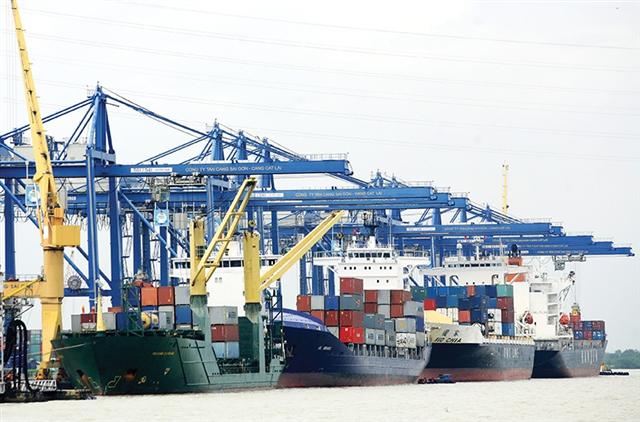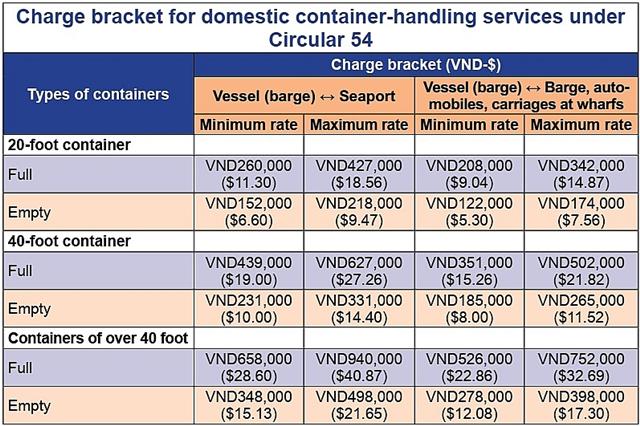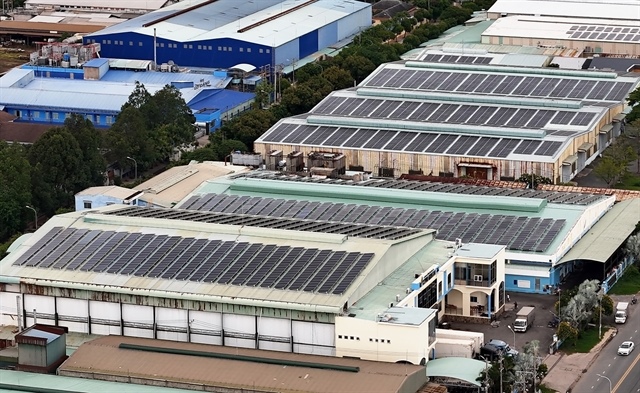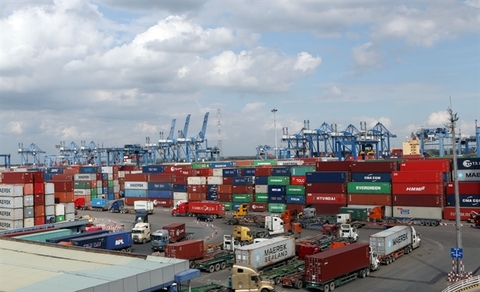Rising handling charges neccessary to advance
Rising handling charges neccessary to advance
International shipping lines are expected to face an increase of 12 per cent in domestic container handling service charges at Vietnamese seaports from early 2022, triggering concerns over a possible charge burden on local shippers.

Rising handling charges neccessary to advance
|
The Ministry of Transport (MoT) is completing the draft amendments to Circular No.54/2018/TT-BGTVT issued in 2018 on the charge bracket for piloting service, container handling service, wharf, docks, and others, with the container handling service to hike 10-12 cent a year at local seaports across areas I, II, and III.
The minimum charge of container handling service for imports and exports at ports in Area I (except for Lach Huyen Seaport) is expected to ascend by 10 per cent a year between 2021 and 2023. The threshold for ports in Area II and Area III (except for seaports in the Cai Mep-Thi Vai area) will be raised by the same rate per year over the time period.
Meanwhile, for Lach Huyen Seaport, the rate is proposed to increase by 10 per cent per year in 2022 and 2023, while the threshold for the Cai Mep-Thi Vai area might rise 10 per cent annually in 2021 and another 10 per cent in 2023.
Ports in Area I include those in the northern localities of Quang Ninh, Haiphong, Thai Binh, and Nam Dinh. Area II includes those in the central region, while Area III covers the southern region.
MoIT Minister Nguyen Van The said at a meeting in late September that review of completion of the draft on increase of the container handling service charge is necessary and reasonable. “This will create a foundation for seaport operators to make gains and then increase service quality by applying advanced technology and upgrading infrastructure, thus increasing competitiveness of Vietnam’s seaports.”
This also aims to make the charge on par with regional peers. Currently, this charge is significantly lower than that applied in Cambodia ($65), Thailand ($59), Malaysia ($75), the Philippines ($98), Indonesia ($81), Singapore ($111), Myanmar ($165), and China ($97). Despite the reasoning, there remain some concerns. A representative of the Vietnam Logistics Business Association said that the increase by roadmap is necessary, but should take careful consideration into specific circumstances.

|
“Logistics firms are facing a difficult time due to the negative impacts of COVID-19. The hike should be made from 2021 with the rate to be decided on circumstances when the prime minister gives permission,” he told VIR. “Relevant agencies like the MoT and the Ministry of Finance should have the tools so that the increase will not lead to a hike in the terminal handling charge (THC) from foreign shipping lines.”
In similar notes, Phan Thong, general secretary of Vietnam Shippers’ Council, which has around 90 members, told VIR, “Any charge increases would cause an impact on businesses. The future hike will not impact manufacturers much, but it will affect trading firms. When the container handling service charge (HSC) rises, foreign shipping lines may raise the THC on shippers, importers, and exporters.”
In late 2018, Vietnam raised the container HSC by around 10 per cent by issuing Circular 54, which took effect from early 2019.
At that time, a leader of the MoT explained that the increase was modest compared to the THC that foreign shipping lines collect from Vietnamese shippers. The THC is $100 per 20-foot container and $150 per 40-foot container, while ports can collect just $46 per 20-foot container and $68 per 40-foot container from international shipping lines for the HSC.
Moreover, the service charge at ports makes up a small part of the total logistics cost. Thus, if this charge at ports was raised by 10 per cent, meaning just 3 per cent of the THC, it was unlikely that international shipping lines would increase the THC for fears of losing customers.
It is possible that foreign shipping lines may take the opportunity to increase the THC because it can help them make gains. In 2017 when Decision 3863 began to take effect, international shipping lines forced ports in the northern city of Haiphong to apply the charge at $30 per 20-foot container, thus reducing revenues of local ports.
For example, Dinh Vu Port reported a fall of VND30 billion ($1.33 million) in revenues, and Haiphong port saw a drop of $5 million in the second half of 2017. Importers and exporters also suffered from the hike as well. Industry insiders said that any new increases should have overall assessment on the involvers to harmonise the benefits of all.



























